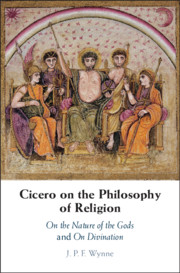Book contents
- Cicero on the Philosophy of Religion
- Cicero on the Philosophy of Religion
- Copyright page
- Dedication
- Contents
- Acknowledgments
- Abbreviations
- Introduction: Cicero and the Translation of Philosophy from Greece to Rome
- Chapter 1 Cicero’s Project in On the Nature of the Gods and On Divination
- Chapter 2 Velleius the Epicurean
- Chapter 3 Balbus the Stoic and Cotta the Skeptic
- Chapter 4 Quintus’ Stoic Case for Divination
- Chapter 5 Marcus’ Arguments against Divination
- Chapter 6 Marcus’ Stance on the Central Question
- Book part
- Bibliography
- General index
- Index locorum antiquorum
Introduction: Cicero and the Translation of Philosophy from Greece to Rome
Published online by Cambridge University Press: 27 September 2019
- Cicero on the Philosophy of Religion
- Cicero on the Philosophy of Religion
- Copyright page
- Dedication
- Contents
- Acknowledgments
- Abbreviations
- Introduction: Cicero and the Translation of Philosophy from Greece to Rome
- Chapter 1 Cicero’s Project in On the Nature of the Gods and On Divination
- Chapter 2 Velleius the Epicurean
- Chapter 3 Balbus the Stoic and Cotta the Skeptic
- Chapter 4 Quintus’ Stoic Case for Divination
- Chapter 5 Marcus’ Arguments against Divination
- Chapter 6 Marcus’ Stance on the Central Question
- Book part
- Bibliography
- General index
- Index locorum antiquorum
Summary
Nineteenth and early twentieth century scholars thought Cicero a bad source for Hellenistic philosophy. They thought that the speeches in his dialogues were translated, often badly, from single sources. Thus they read him only to reconstruct his sources by Quellenforschung. I first give a sympathetic account of these scholars’ projects, which is often dismissed too easily today. Second, I give a complete argument that these scholars were wrong, and that today’s more positive, but often incompletely defended, view of Cicero is correct. Third, I argue that Cicero wrote dialogues not only to introduce Hellenistic philosophy to a Latin audience, but also as literary unities to impress a learned Roman audience who already knew philosophy in Greek. His models for the dialogue form were Plato, Aristotle, and Heraclides of Pontus, but he adapted it to to serve his radical Academic skepticism, in which he followed Carneades and Clitomachus. He hoped to be the model for a Latin tradition of good writing about philosophy, that would "illuminate" both philosophy and Latin. Cicero’s creativity as a philosophical author shows why Quellenforschung failed, and that he is a good source for Hellenistic thought.
- Type
- Chapter
- Information
- Cicero on the Philosophy of Religion<I>On the Nature of the Gods and On Divination</I>, pp. 1 - 49Publisher: Cambridge University PressPrint publication year: 2019

